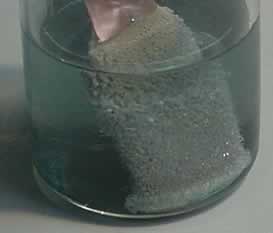A reactive metal
is one that readily reacts with other elements to give up its electrons.
The most reactive metals will react even with water, while the least reactive
will not react, even with concentrated acid. Aluminium is a very reactive
metal, almost as reactive as sodium. Aluminium reacts vigorously with
water to produce hydrogen gas and yet we make cooking pots and ships from
aluminium.
Click
to see a 120kb movie of how reactive sodium is when placed in water.
Click for more information
on the reactivity of aluminium with water.
Testing the reactivity of a series of metals
You will need
2 cm strip of
each of the following:
- magnesium (Mg)
- zinc (Zn)
- tin (Sn)
- copper (Cu)
- lead (Pb)
Clean iron nail (Fe)
2 small granules of calcium (Ca)
6 test-tubes each containing about
15 ml of water
bottle of 5 M hydrochloric acid test-tube rack
6 paper labels matches
Place each of
the metals in turn in a clean test-tube containing water and labeled with
the symbol of the metal added.
If bubbles of a gas are evolved, test the gas with a lighted match, this
is called the pop test.
If there is a slight explosion or pop, hydrogen has been displaced from
the acid.
Note: Hydrogen is explosive. so do not carry out the reaction near a naked
flame.
For any metal that has not reacted with the water, decant the water from
the test tube leaving the unreacted metal. Cover each metal with a small
amount of dilute hydrochloric acid. Note any reactions.
Record your results in a table and classify each metal under the following
categories.
Metals that displace hydrogen from water
Metals that displace hydrogen from dilute acid
Metals that do not displace hydrogen from either
PART 2
Ranking some metals in order of reactivity
The previous experiment
allowed us to classify the metals tested into three groups. However, we
were not able to distinguish which of the metals within a group were more
or less reactive than others in that group. The following experiment allows
us to rank the metals from most reactive to least reactive.
A metal will displace a less reactive metal from its solution. For example.
a piece of zinc will displace copper from a solution of a copper salt
because the zinc is more reactive than the copper.
Aim - To obtain the relative order of reactivity of some common metals.
Equipment
test-tubes
2 cm lengths of zinc, magnesium, tin, iron, copper
solutions of zinc nitrate, tin nitrate , iron nitrate , magnesium nitrate,
copper nitrate, lead nitrate.
Method
Step 1 -Clean
each piece of metal with steel wool to remove any oxide
coating.
Start with magnesium
Place a piece of magnesium in solutions of zinc nitrate.
Place a piece of magnesium in tin nitrate solution.
Place a piece of magnesium in iron nitrate solution
Place a piece of magnesium in copper nitrate solution
Place a piece of magnesium in lead nitrate solution
Question
Does magnesium displace any of these metals from their solutions? If
so, you will notice a reaction occurring around the piece of magnesium.
Cross out the incorrect word in these sentences. If a reaction is observed
then magnesium is more reactive than the metal in the solution.
Magnesium is more/less reactive than zinc
Magnesium is more/less reactive than tin
Magnesium is more/less reactive than iron
Magnesium is more/less reactive than copper
Magnesium is more/less reactive than lead
Repeat step 1 with each metal.
Record your results in the table below. Click the box if the metal atom in the solution is less reactive than the solid metal. Silver has already been done as an example.
| When copper metal was placed in a solution of silver nitrate (AgNO3) silver was deposited on the copper while the copper dissolved. The copper displaced the silver. Silver is therefore less reactive than copper. The table below is filled in for silver and tin. Notice how silver is less reactive than all the metals tested. In other words silver atoms in solution will deposit themselves on all the metals that we are testing. Click to see a time-lapse of the reaction between silver nitrate and copper metal. |  |
|
|
Metal solutions |
Mg |
Cu |
Ag |
Pb |
Sn |
Zn |
Fe |
|
Metal |
||||||||
|
Magnesium(Mg) |
|
|
|
|
|
|
||
|
Copper(Cu) |
|
|
|
|
|
|
||
|
Silver(Ag) |
No
|
No
|
No
|
No
|
No |
No
|
||
|
Lead(Pb) |
|
|
|
|
|
|
||
|
Tin(Sn) |
|
|
|
|
|
|
||
|
Zinc(Zn) |
|
|
|
|
|
|
||
|
Iron(Fe) |
|
|
|
|
|
|
Place the metals
in order from most reactive to least reactive..